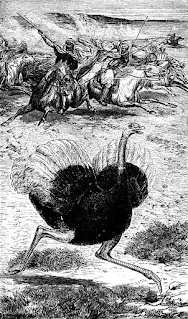25+ Interesting Facts About Ostriches
- Ostrich, a flightless bird, is the largest living bird. The height of an adult male is more than 7 feet.
- Ostrich also lays the largest egg of any bird. On average, these eggs are 13 cm wide, 15 cm long, and weigh 1.4 kg.
- Ostrich eggs are the smallest ones relative to the size of the bird. These eggs are just 1 to 4% the size of the female ostrich.
- Ostriches have three stomachs and an extremely long intestine that takes 36 hours to digest food, pebbles, and other hard materials. This complex digestive system is the reason for ostriches having separate systems for urination and defecation. All the other birds have a single system for both of these functions. (Source)
- An important feature that distinguishes ostriches from other birds is two toes on each foot. Flying birds have four toes on each foot, while other flightless birds have three toes per foot.
- Ostrich’s eye is 5 meters across. It is bigger than the bird’s brain and the largest eye of any living land animal.
- There
are two extant species of ostriches: Common Ostrich and Somali Ostrich. The common
ostrich is slightly larger of the two. Both these species of extant ostriches are present in Africa only.

Somali Ostrich is slightly smaller than common ostrich - The legs of ostriches are very powerful. They can kill human beings and also big animals like a lion with their powerful kick. (Source)
- At the time of danger, the common ostrich can achieve a speed of 70 km/h. They also can maintain a 50 km/h speed for a long duration. It makes the common ostrich the fastest animal with two legs.
- The most common predators of ostrich include lions, leopards, cheetahs, spotted hyenas, and African hunting dogs. Cheetahs are the most successful hunters of ostriches due to their speed. Ostriches can outrun all other predators.
- Ostriches have advanced eyesight and hearing. They can locate predators from far away thanks to their strong senses.
- Ostriches are mainly vegetarians and feed on fruits, seeds, grass, flowers, and shrubs. They occasionally eat a few insects (like locusts) and lizards.
- They can’t chew their food due to the absence of teeth. Ostriches swallow pebbles to grind food inside their digestive system.
- The average lifespan for ostriches in the wild is 40 years. They can live for more than 60 years in captivity.
- It is a common myth that ostriches bury their head in the sand to avoid danger. They either do this to take pebbles from sand for digestive purpose, use it as a defensive technique, or rotate eggs during incubation.
- Ostriches can survive without drinking water for several days. They have an efficient water conservation system and can compensate unavailability of water by eating water-rich plants.
- Ostriches cannot use their wings for flight, but they fulfill several other purposes. These wide wings work as stabilizers during running, especially while changing direction. (Source)
- Ostriches are the only flightless birds (ratites) where males and females both take part in incubating eggs and caring for their young ones. In all other ratites, these duties are performed solely by male birds. Female ostriches incubate by day, while males perform the same by night.
- Male ostriches are larger and darker than females. The male performs a special dance and calls to prepare the female for mating. (Source)
- Ostriches spend the winter months either alone or in pairs. They live in nomadic groups of 5 to 100 birds during rainless periods of the breeding season. There are several female ostriches (hens) in a group. All the hens put their eggs in the wide nest of the dominant hen.
- It has been confirmed that there were few extinct species of ostriches in Asia (e.g. in the Arabian Peninsula, Asia Minor, and the subcontinent). Over-hunting was the main cause of the extinction of these birds.

Over-hunting caused extinction of ostriches in Asia - Ostrich racing is popular in South Africa and a few parts of the USA. They can run fast and cover up to 16 feet in a single stride. (Source)
- Ostriches provide several benefits to humans. Their meat and eggs are consumed as food. Apart from that, their feathers and bones are used in traditional medicines in Africa. (Source)
- During mating season, the beak and shin of males turn red. On the other hand, females’ feathers turn silver when they are ready to mate.
- North Korea once tried to solve the issue of food shortage with ostrich farms. The experiment proved unsuccessful. (Source)
- Ford uses ostrich feathers to clean their cars. It is because ostrich (especially female) feathers are excellent at collecting tiny dust particles. (Source)
- Scientists in the 19th Century had the view that ostriches and other big birds (emus and rhea) experience blood-based erections. It was contrary to lymph-based erections in other birds with a penis. But the latest research proves that ostriches and their relatives also have the same lymph-based erections like most other birds. (Source)
- Ostrich’s legs are placed perfectly according to the position of their body. It keeps their large bodies upright.



Comments
Post a Comment